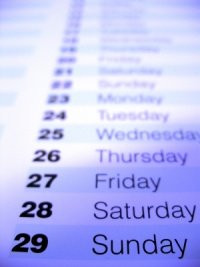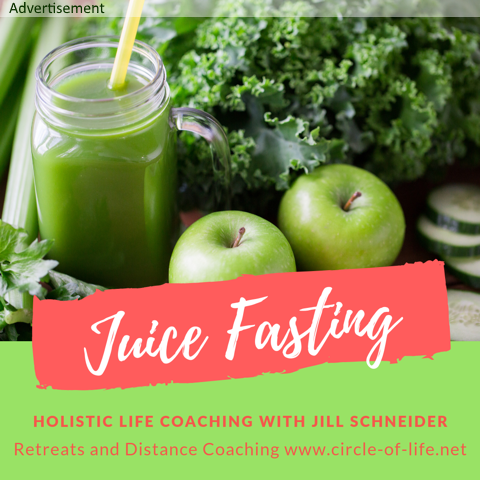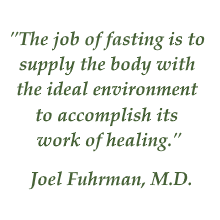How Long Should You Fast?
While a three day fast is an excellent option and can fit nicely into a weekend, there are other standard lengths. Give careful consideration when deciding how long to fast.
If you've never fasted before, a commitment of a day or less is easier to accomplish and will familiarize you with the process. Use that first experience to learn what your body's particular reactions are. Every body is unique. You need to learn about yours.
Transition periods
Keep in mind that the time commitment is longer than the actual fast. There are the transition periods both before and after, during which you ease away from your full diet and then ease back toward it.
The length of your transition periods can be based upon the length of the fast. You would take half the number of days of the fast for each transition period, essentially doubling the number of days between start and finish. So a 10 day fast would then require 20 days of attention and commitment from you. A three day fast would take 6.
Many feel 4 days is sufficient transition for both before and after any length fast. This assumes, however, that you are embarking on a new healthier eating plan, and not delving straight into junk food on the 5th day.
For a three day fast, you'll want to allot at least a day before and a day after. One day fasts can be begun with a light dinner the night before. Although, keep in mind that the longer you spend acclimating your body beforehand, the easier (more comfortable) your fast will be.
I've spent 5 days cleaning up my diet and scaling back portions for just a one day fast. It occurred more by happenstance than by design, but the day long fast was so much more comfortable and enlightening. And I enjoyed the mental/emotional and spiritual benefits of fasting much longer afterward.
Choosing a length
Length of time for a fast should always be the length that is right for you at the time. Remain flexible. Of course you'll have a goal in mind when you begin, but don't be too inflexible to end the fast should your body signal. Severe pain and discomfort may mean you have attempted too much, too soon. You can back off a bit, eating a small piece of fresh fruit for now, and consider spending some time on a cleansing diet before your next fast.
Longer-term fasters are advised to break their fast if and when "true hunger" appears. Guidelines for Breaking a Fast has information on the foods to use, their quantities and frequency.
Be careful not to fast too frequently; allow your body sufficient time to rebuild nutritional reserves. Two days per week is too frequent, as is one week every month. Recommended fasting times for regular, occasional "maintenance" and rebalancing are one day per week and/or 3 days per month and/or 10 days yearly.
Most common lengths for fasting

While these are the most common lengths for fasting, any amount of time can be chosen, depending on your particular situation.
- One day fast or 24-hour fast. This is the
recommendation for beginners. But don't discount even shorter fasts if you've never fasted before. Sixteen hour fasts can
be helpful, as can adhering to the natural nightly fast of 10-12 hours.
One day fasts are good when you feel something coming on, at the first sign of illness. It allows the body the resources to fight it off early.
Click here for instructions on a one day apple fast.
- Three-day fast. Good to perform monthly as a sort
of "maintenance" routine, to keep toxins cleansed regularly.
To fit in a three day fast with a work schedule, Dr. Fuhrman suggests beginning a fast after Friday morning's breakfast and continuing through Sunday night. Friday's breakfast will provide the energy and sustenance needed for the day's work, but Saturday and Sunday should be kept free for bed rest if needed. Break the fast Sunday evening with a meal of fresh fruit, and you'll be ready for work again on Monday. (But now you'll be revitalized and clearer minded!)
Here are guidelines for a one to three day fast using apples. - One week fast. Often used as a quarterly (seasonal) cleansing detox.
- 10-day fast. This is the standard recommended length for a
Master Cleanse fast. Also, many use this length as a yearly
maintenance detox and cleansing.
January is a popular month for such a yearly cleanse, even though those in cold climes would actually be better off waiting until warmer months to fast. - Several week fast.
These are only for the seasoned or those under
close professional supervision. It's best to have plenty of
experience under your belt before tackling a long-term fast. You need
to be familiar with your own body and it's unique reactions to the
fasting process.
Dr. Fuhrman, who treats chronic medical conditions with therapeutic water fasting, generally recommends fasts from 14 to 21 days (with professional supervision), and on occasion recommends 28 days.
The nutritional reserves of an individual play an important role in how long one can fast, and individuals of normal weight generally shouldn't water fast longer than three weeks or as Fuhrman states, they "can become so thin that they have a long road back regaining their strength". - Intermittent fasting. Intermittent fasting
is a newer technique of using fasting in an on/off or start/stop
fashion. Each week certain days (or hours) are chosen to be fasting days and the
other days to be regular eating days. Usually one to two days per week
are used for fasting. Usually, but not always, "partial fasting" is used, where food is ingested in small quantity and restricted in calories.
Purposes of the different lengths
According to the Balchs' book, Prescription for Nutritional Healing, considered by many to be a modern-day bible on natural health and healing, different length fasts accomplish different things:
- three day fast - aids in eliminating toxins and cleanses the blood
- five day fast - begins "healing and rebuilding the immune system"
- ten day fast - heads off problems in the making and helps to prevent illness, including degenerative diseases
When to seek supervision
More stringent guidelines recommend you have supervision by a fasting professional whenever attempting a fast longer than 3-5 days. Looser guidelines suggest that up to 10 days is ok for the partial fasts that include some nutrition.
For water fasts, however, you should have supervision before attempting a fast longer than 3 days due to rare problems that can occur. See the water fasting page for the particulars on water fasts.
For fasting supervision, the International Association of Hygienic Physicians (IAHP) is an organization of primary care physicians who are trained in fasting supervision. They must pass certification standards that include a six-month internship. See here for their home page: http://www.iahp.net
Also, while he is an advertiser on this site, Dr. Colafranceschi offers distance fasting supervision. We've talked extensively on the phone and I wrote up some information about him here, to help people learn more about his services.
Fasting without supervision means you must watch any detox symptoms carefully, and don't push yourself. Ease up or end the fast if symptoms become severe. Don't let anyone convince you to continue since it's "for your own good"; your first responsibility is to yourself so you must listen to your own guidance.
If you have significant medical conditions, consider going on a fasting retreat where you would get constant personal attention.
Someday soon I hope to provide more information on these retreats.
When deciding, say, between a three day fast and a ten day, consider your lifestyle and commitments. How much of yourself can you realistically commit at this time? Longer fasts take more than just greater length of time, they'll require greater support and understanding from family and friends and greater awareness on your part of your body's reactions.
Plan on doing longer fasts when the time is right and you can be truly devoted to the process, instead of trying to squeeze them into a too busy life. Fasting of any length should be approached as an inner experience if you want to gain the greatest benefit.
You may also like
Staying safe requires knowing the Precautions to Fasting before beginning.
Understanding Ketosis Explains the muscle-sparing process of the body during different types of fasts.
True Hunger is the signal to break a fast. Learn what it is and how to identify it.
How to use a Cleansing Diet as a partial fast or as preparation for other types of fasting.
Water Fasting Tips offers guidance and support useful during any type of fast. Helpful in "getting over the hump".
Recent Posts
-
Valter Longo and the Longevity Diet
Valter Longo's Longevity Diet, which is a fasting mimicking diet, is showing great promise as a prescribed therapy. If you haven't heard of Valter Longo, check out his newly launched website to follow… -
Fasting Overview for Beginners
Information on fasting especially geared toward the beginner. Important guidelines on fasting including the contraindications and how to do a simple one-day fast. -
Meat vs. Vegan | AllAboutFasting
Confusion seems to arise as to whether this site promotes meat-eating or veganism. Let's set the record straight and talk about ideal diets. Ideal for whom? Each of us individually.

